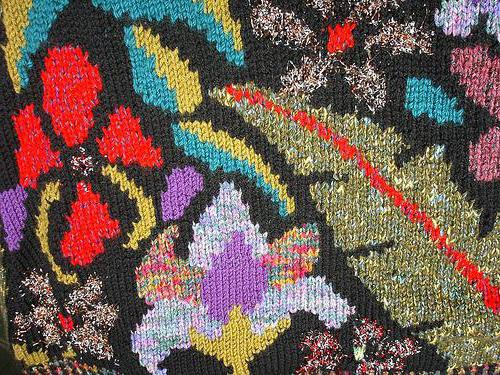
Surely, many of you are led into indescribabledelight knitwear, which resemble colorful Turkish high-quality carpets or colorful paintings of famous artists. And in most cases, needlewomen believe that this technique is complex and incomprehensible, which in fact is completely wrong.
Multicolored patterns, geometric and not veryknit in the technique of "intarsia". Knitting with knitting needles, technique, a master class with detailed instructions - all this you will find in this article. Note that it is possible to apply this technique for machine knitting, which is a big plus for many needlewomen.

Knitting in the technique of "intarsia" is acanvas with multi-colored areas, for the production of which, like in jacquard knitting, several coils of yarn of different shades are used at once. But there are some differences. When knitting products in jacquard technology, the threads pass on the underside of the product. Here, the threads will be crossed according to a certain technique. Due to simple manipulations, multi-colored squares, rhombuses and triangles are obtained.
Most often knitting in the technique of "intarsia" isusual facial smoothness. In some cases, having experience and skill, knitters experiment with other simple patterns, which effectively look exactly in a multi-colored performance.
Let's look at a few options thatmost often used in knitting in this technique. The most popular is knitting vertical lines. How to make a replacement of flowers in such a way that the product does not break up into pieces? Let's understand.
What is "intarsia" (knitting with knitting needles)? Technique for vertical knitting is offered to your attention.
First, let's see how to replace the thread if the front row is tied.

The reverse side of the product is now considered.
Consider knitting in the technique of "intarsia" (diagonal on the right).
We will analyze knitting in the technique of "intarsia" (diagonal on the left).

Many needlewomen who have just startedmaster this technique, are asked by the question, which is related to the number of coils for this knitting. Here you can not find an unambiguous answer. Everything will depend on how many colors you intend to use to create this or that knitted product.
Also, the moment is very important where it will bethere is a change of color during knitting. If the threads change from the edges of the product, then one ball of each color is enough. But if you want to make a more complex drawing and change the threads in the center of the product or in its individual parts, you will have to unroll one large bundle into a few small ones and use them.
This method of numerous smallglomeruli is very convenient if you intend to perform the technique of "intarsia" crochet. The knitting technique here will be similar to that used in knitting on knitting needles. Many needlewomen even say that the hook gives a clearer result of the color change. Yes, and knit with a hook for many more convenient than on knitting needles.

When knitting in the "intarsia" technique, manyneedlewomen recommend using special additional tools. For example, a thimble with hooks is very convenient for work, for which it is good to cling multicolored threads so that they are not entangled during knitting. Some experienced needlewomen use their own fingers instead of such thimbles, winding the thread on them. But this method is already suitable for those who have some skills in this technique.
If you need a lot of small balls, thenwe recommend using self-made or purchased coils for yarns. They look like elongated pieces of cardboard (or plastic) with holes for winding threads at the top and bottom. With the help of such devices it is possible to greatly simplify the work and increase the speed of its implementation. In this thread will never get tangled.
